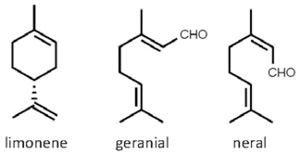 Aloysia citrodora
Aloysia citrodora
lemon verbena • vervain
Back to “Culinary herbs: lemon verbena (Aloysia triphylla)*”
Aloysia citrodora Palau[= A. triphylla (L’Herit.) Britton; Lippia citriodora H.B.K.; L. triphylla (L’Herit.) Kunze] (Verbenaceae); sitroenverbena (Afrikaans); verveine odorante (French); Zitronenstrauch (German); limoncina, erba luigia, cedrina (Italian); verbena olorosa, hierba luisa (Spanish)
DESCRIPTION The leaves are somewhat rough in texture and have a very strong smell of lemon when crushed. They are used (fresh or dried) in cookery, while the essential oil or solvent extracts are used in aromatherapy, perfumery, soaps and cosmetics. The correct scientific name is Aloysia citrodora1 and synonyms include Lippia citriodora and Aloysia citriodora.1,2
THE PLANT A deciduous, woody shrub of up to 3 m (ca. 10 ft) high with aromatic leaves in whorls of three or four and small, pale mauve flowers in loose panicles. The leaves are highly aromatic and have a sandpapery texture.
ORIGIN South America (indigenous to Argentina and Chile). The Spaniards brought it to Europe in the 18th century.
CULTIVATION This is one of the most rewarding flavour plants to grow in the herb garden and it is useful to have a regular supply of fresh leaves. Full sun (or at least morning sun) is required, as well as a light loam soil and regular watering. It can withstand mild frost but in northern regions it is kept indoors during the winter. The plant is easily propagated from cuttings but can also be grown from seeds. Regular pruning is beneficial as the shrub often tends to become untidy. Commercial plantings are found in many parts of the world, including France and Spain.
HARVESTING Commercial harvesting is done in early summer at full bloom and again in autumn. The leafy flowering tops are cut and dried in the shade. Steam distillation for the valuable essential oil (known as lemon verbena oil or verbena oil) should follow soon after harvesting to ensure better quality and higher yields (up to 1% dry weight but more often less than 0.5%).
CULINARY USES Lemon verbena may be used as a substitute for lemongrass and as a refreshing lemon flavour ingredient in stews, soups and stir-fries (remove the leaves before serving as they are leathery and not edible). It is excellent for flavouring summer drinks and can be included in salads, fruit salads, baked custard, rice puddings and jams. Fresh leaves may be used to flavour stocks for seafood dishes, while dried and powdered leaves can be added to fish and meat stuffings.3 The main commercial uses are for health teas, tisanes, various liqueurs and fruit juice drinks.
FLAVOUR COMPOUNDS Oil of verbena contains limonene (hence the lemon smell) and citral as main compounds.4,5 Citral is a mixture of geranial (also known as citral A) and neral (also known as citral B). The presence of many other components, including carvone, geraniol, linalool and others add to the intensity and complexity of the flavour.

NOTES Lemon verbena tea is believed to have digestive, antispasmodic and sedative properties. Dried leaves are commonly used as an ingredient of potpourri.2
1. Armada, J., Barra, A. 1992. On Aloysia Palau (Verbenaceae). Taxon 41(1): 88–90.
2. Mabberley, D.J. 2008. Mabberley’s plant-book (3rd ed.). Cambridge University Press, Cambridge.
3. Larousse. 1999. The concise Larousse gastronomique. Hamlyn, London.
4. Harborne, J.B., Baxter, H. 2001. Chemical dictionary of economic plants. Wiley, New York.
5. Argyropoulou, C., Daferera, D., Tarantilis, P.A., Fasseas, C., Polissiou, M., 2007. Chemical composition of the essential oil from leaves of Lippia citriodora H.B.K. (Verbenaceae) at two developmental stages. Biochemical Systematics and Ecology 35(12): 831–837.